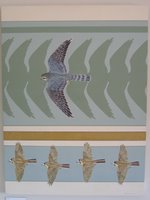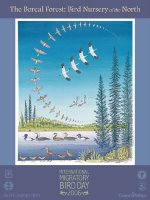Raptors and Radeaux
 Raptors stand out as my favorite species group. This fall, Cape May Bird Observatory’s research and education center featured raptor artwork in its gallery, so I had to investigate.
Raptors stand out as my favorite species group. This fall, Cape May Bird Observatory’s research and education center featured raptor artwork in its gallery, so I had to investigate.Three paintings especially grabbed my attention: a Merlin (left), an American Kestrel and a Peregrine Falcon (a species that holds a special place in my heart). I vowed to learn more about the artist, Radeaux. (Click on the paintings for larger images.)
Coincidentally, Radeaux created the poster for International Migratory Bird Day 2006. The May 13 event will focus on the boreal forest, “the bird nursery of the North.”
But back to raptors. From Colorado, Radeaux graciously replied to some questions about his paintings and his birding.
 The artist said his bird paintings are loosely based on his experiences in the field. “For example, the Peregrine and White-throated Swift painting [left] is about seeing an adult Peregrine carrying prey and flying in front of one of its offspring. It then dropped the prey, which turned out to be a White-throated Swift. I watched the young Peregrine catch the swift.”
The artist said his bird paintings are loosely based on his experiences in the field. “For example, the Peregrine and White-throated Swift painting [left] is about seeing an adult Peregrine carrying prey and flying in front of one of its offspring. It then dropped the prey, which turned out to be a White-throated Swift. I watched the young Peregrine catch the swift.” The stylized image on the American Kestrel painting is from a pottery painting from New Mexico, Radeaux said. “I’ve identified the image as a kestrel. Archaeologists are wary of interpreting images too much, but as an artist, I have more latitude.”
The stylized image on the American Kestrel painting is from a pottery painting from New Mexico, Radeaux said. “I’ve identified the image as a kestrel. Archaeologists are wary of interpreting images too much, but as an artist, I have more latitude.”Radeaux started painting birds in 1973. “I was a birder first and then an artist,” he said. “I started painting with no particular direction after college. I did a drawing of a Rock Pigeon, and it was so bad that it gave birth to a personal challenge to do a decent painting of a bird.
“It is still a challenge, but I am better at it,” he said. “The challenges in art keep me going as a painter.”
The painter began birding more than 40 years ago. “The first bird I noticed as a child (I can't remember how old) was a male Western Tanager outside our kitchen window,” he said. “My dad had a Peterson field guide, and I looked it up. I really got hooked on birding during a trip to the Monte Vista National Wildlife Refuge when I was a teenager.”
 In addition to Monte Vista, Colorado contains many appealing spots for Radeaux. “Colorado has so many places with scenic backdrops, and the birds are a bonus,” he said. “As far as my favorite spot, I will have to say ‘there's no place like home.’
In addition to Monte Vista, Colorado contains many appealing spots for Radeaux. “Colorado has so many places with scenic backdrops, and the birds are a bonus,” he said. “As far as my favorite spot, I will have to say ‘there's no place like home.’“It's not just that my home territory is convenient; the convergence of habitats in Pueblo County makes it the most biologically diverse county in Colorado," he said. "More than 400 bird species have been seen in the county.
“I regularly go to the Arkansas Riverwalk within the city limits; City Park, an old-growth park within the city; and Valco Ponds, a state wildlife area just outside the city.”
During more than 40 years of birding, Radeaux said the joy of discovery is the most rewarding experience. He narrowed it down to just three examples, adding “This is tough.”
1. Watching a Black-chinned Hummingbird gather spider web and carry it to a nest on my front porch. The same nesting season I watched a Mississippi Kite carry nesting material to a nest in my back yard. I then got to observe both the entire nesting season.
2. Finding the first documented record of Acorn Woodpeckers in Colorado.
3. Discovering the second nesting record of a Black Phoebe in Colorado.
“The joy of discovery is augmented by being able to share these findings,” Radeaux said, “whether it be by showing these birds to other interested people or by making paintings of the experience. Most of my rewarding discoveries become paintings eventually. Sometimes they become multiple paintings.”
Creating a painting for International Migratory Bird Day 2006 was a natural fit for Radeaux. “Our Audubon chapter, Arkansas Valley Audubon, has conducted a bird survey on International Migratory Bird Day for years.
“Years ago, I did some illustrations for some of the IMBD publications, and being asked to do the poster for this year on the boreal forest was a pleasure,” he said. “I got my first exposure to wood-warblers in the boreal forest in Canada and northern Minnesota when I was in college. The boreal forest is an incredibly sensitive and important place for birds and a host of other creatures.”
You can see more of Radeaux’s work at CMBO’s Research and Education Center (it currently displays some of his winter birds) and at the John Deaux Art Gallery, 221 S. Union Ave. in Pueblo, Colorado (719-545-8407).


4 Comments:
What an amazing artist. Thanks for sharing, Amy!
My pleasure, Mike (c:
and to think, I get to work for such a freaking genius!
This comment has been removed by the author.
Post a Comment
<< Home